Discover 35 hidden attractions, cool sights, and unusual things to do in Delhi (India). Don't miss out on these must-see attractions: Humayun's Tomb, Qutb complex, and Red Fort. Also, be sure to include National Museum in your itinerary.
Below, you can find the list of the most amazing places you should visit in Delhi (National Capital Territory of Delhi).
Table of Contents
Humayun's Tomb
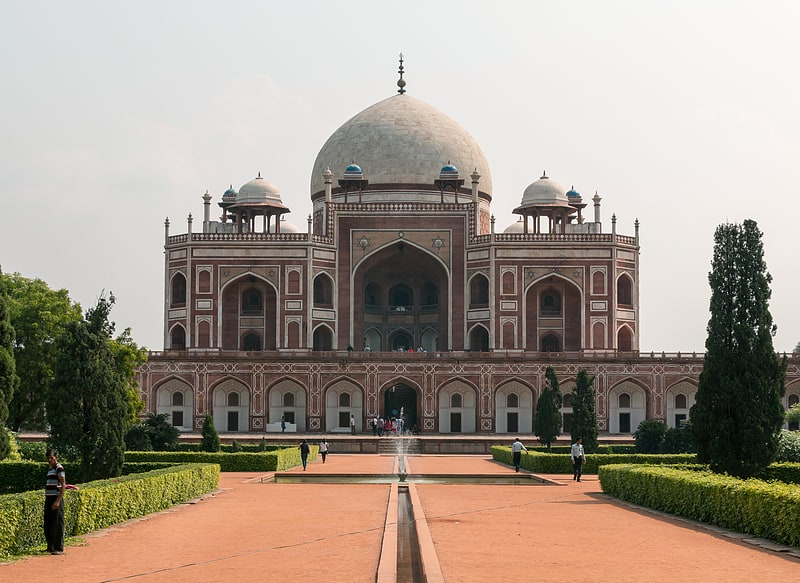
Also known as: हुमायूँ का मकबरा
Historical landmark in New Delhi, India. Humayun's tomb is the tomb of the Mughal Emperor Humayun in Delhi, India. The tomb was commissioned by Humayun's chief consort, Empress Bega Begum, in 1558, and designed by Mirak Mirza Ghiyas and his son, Sayyid Muhammad, Persian architects chosen by her. It was the first garden-tomb on the Indian subcontinent, and is located in Nizamuddin East, Delhi, India, close to the Dina-panah Citadel, also known as Purana Qila, that Humayun found in 1533. It was also the first structure to use red sandstone at such a scale. The tomb was declared a UNESCO World Heritage Site in 1993, and since then has undergone extensive restoration work, which is complete. Besides the main tomb enclosure of Humayun, several smaller monuments dot the pathway leading up to it, from the main entrance in the West, including one that even pre-dates the main tomb itself, by twenty years; it is the tomb complex of Isa Khan Niyazi, an Afghan noble in Sher Shah Suri's court of the Suri dynasty, who fought against the Mughals, constructed in 1547 CE.
The complex encompasses the main tomb of the Emperor Humayun, which houses the graves of Empress Bega Begum, Hamida Begum, and also Dara Shikoh, great-great-grandson of Humayun and son of the later Emperor Shah Jahan, as well as numerous other subsequent Mughals, including Emperor Jahandar Shah, Farrukhsiyar, Rafi Ul-Darjat, Rafi Ud-Daulat, Muhammad Kam Bakhsh and Alamgir II. It represented a leap in Mughal architecture, and together with its accomplished Charbagh garden, typical of Persian gardens, but never seen before in India, it set a precedent for subsequent Mughal architecture. It is seen as a clear departure from the fairly modest mausoleum of his father, the first Mughal Emperor, Babur, called Bagh-e Babur (Gardens of Babur) in Kabul (Afghanistan). Though the latter was the first Emperor to start the tradition of being buried in a paradise garden. Modelled on Gur-e Amir, the tomb of his ancestor and Asia's conqueror Timur in Samarkand, it created a precedent for future Mughal architecture of royal mausolea, which reached its zenith with the Taj Mahal, at Agra.
The site was chosen on the banks of Yamuna river, due to its proximity to Nizamuddin Dargah, the mausoleum of the celebrated Sufi saint of Delhi, Nizamuddin Auliya, who was much revered by the rulers of Delhi, and whose residence, Chilla Nizamuddin Auliya lies just north-east of the tomb. In later Mughal history, the last Mughal Emperor, Bahadur Shah Zafar took refuge here, during the Indian Rebellion of 1857, along with three princes, and was captured by Captain Hodson before being exiled to Rangoon. At the time of the Slave Dynasty this land was under the 'KiloKheri Fort' which was capital of Sultan Qaiqabad, son of Nasiruddin (1268–1287).
The Tombs of Battashewala Complex lie in the buffer zone of the World Heritage Site of the Humayun Tomb Complex; the two complexes are separated by a small road but enclosed within their own separate compound wall.[1]
Address: Mathura Road, 110013 New Delhi (Central Delhi)
Qutb complex

Also known as: कुतुब परिसर
Ruins from an ancient Muslim sultanate. The Qutb Minar complex are monuments and buildings from the Delhi Sultanate at Mehrauli in Delhi, India. Construction of the Qutub Minar "victory tower" in the complex, named after the religious figure Sufi Saint Khwaja Qutbuddin Bakhtiar Kaki, was begun by Qutb-ud-din Aibak, who later became the first Sultan of Delhi of the Mamluk dynasty. It was continued by his successor Iltutmish, and finally completed much later by Firoz Shah Tughlaq, a Sultan of Delhi from the Tughlaq dynasty in 1368 AD. The Qubbat-ul-Islam Mosque, later corrupted into Quwwat-ul Islam, stands next to the Qutb Minar.
Many subsequent rulers, including the Tughlaqs, Alauddin Khalji and the British added structures to the complex. Apart from the Qutb Minar and the Quwwat ul-Islam Mosque, other structures in the complex include the Alai Darwaza gate, the Alai Minar and the Iron pillar. The Quwwat ul-Islam Mosque was originally built from the remains of 27 older Hindu and Jain temples. The pillars of the temples were reused and the original images plastered over. Inside the complex lie the tombs of Iltutmish, Alauddin Khalji and Imam Zamin.
Today, the adjoining area spread over with a host of old monuments, including Balban's tomb, has been developed by the Archaeological Survey of India (ASI) as the Mehrauli Archaeological Park, and INTACH has restored some 40 monuments in the Park. It is also the venue of the annual 'Qutub Festival', held in November–December, where artists, musicians and dancers perform over three days.[2]
Red Fort
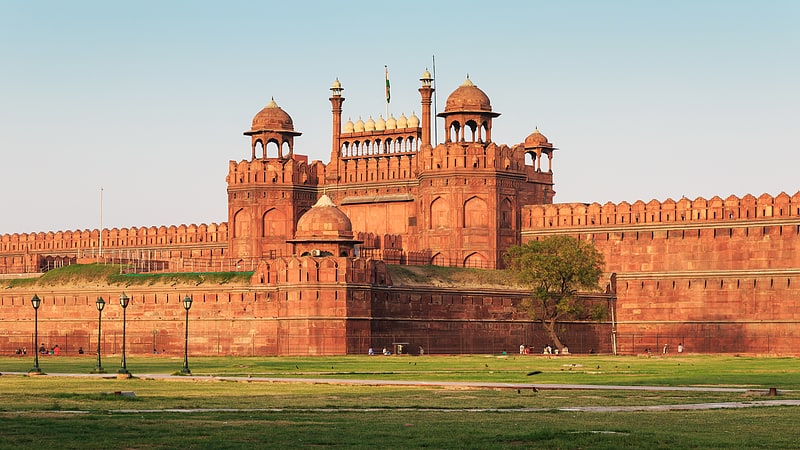
Also known as: लाल क़िला
Iconic 1600s imperial residence and museum. The Red Fort or Lal Qila is a historic fort in Old Delhi, Delhi in India that served as the main residence of the Mughal Emperors. Emperor Shah Jahan commissioned construction of the Red Fort on 12 May 1638, when he decided to shift his capital from Agra to Delhi. Originally red and white, its design is credited to architect Ustad Ahmad Lahori, who also constructed the Taj Mahal. The fort represents the peak in Mughal architecture under Shah Jahan, and combines Persianate palace architecture with Indian traditions.
The fort was plundered of its artwork and jewels during Nadir Shah's invasion of the Mughal Empire in 1739. Most of the fort's marble structures were subsequently demolished by the British following the Indian Rebellion of 1857. The fort's defensive walls were largely undamaged, and the fortress was subsequently used as a garrison.
On 15 August 1947, the first Prime Minister of India, Jawaharlal Nehru, raised the Indian flag above the Lahori Gate. Every year on India's Independence Day (15 August), the Prime Minister hoists the Indian tricolour flag at the fort's main gate and delivers a nationally broadcast speech from its ramparts.
The Red Fort was designated a UNESCO World Heritage Site in 2007 as part of the Red Fort Complex.[3]
Address: Netaji Subhash Marg, 110006 New Delhi (Central Delhi)
National Museum
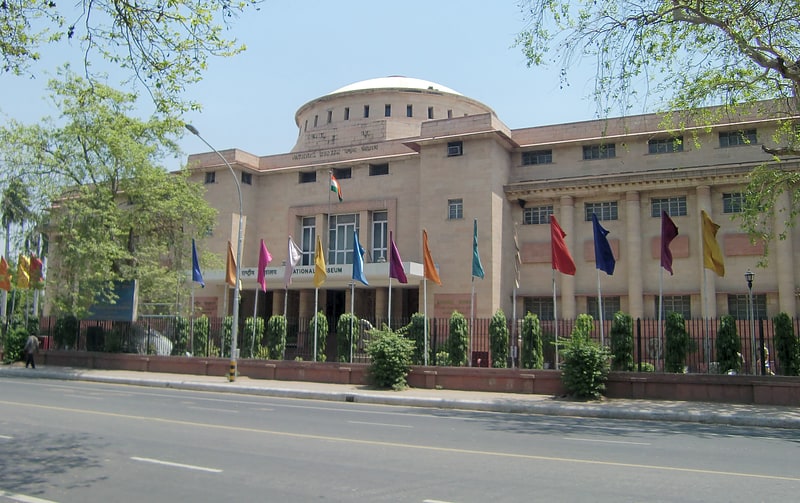
Also known as: राष्ट्रीय पुरातात्विक संग्रहालय, नई दिल्ली
Museum in New Delhi, India. The National Museum in New Delhi, also known as the National Museum of India, is one of the largest museums in India. Established in 1949, it holds a variety of articles ranging from pre-historic era to modern works of art. It functions under the Ministry of Culture, Government of India. The museum is situated on Janpath. The blue–print of the National Museum had been prepared by the Gwyer Committee set up by the Government of India in 1946. The museum has around 200,000 works of art, mostly Indian, but some of foreign origin, covering over 5,000 years.
It also houses the National Museum Institute of History of Art, Conservation and Museology on the first floor which was established in 1983 and has been to be a university since 1989, and runs Masters and Doctoral level courses in art history, conservation and museology.[4]
Address: Janpath Rd, 110011 New Delhi (New Delhi)
Qutb Minar

Also known as: क़ुतुब मीनार
5-storey victory tower with balconies. The Qutub Minar, also spelled as Qutb Minar and Qutab Minar, is a minaret and "victory tower" that forms part of the Qutb complex, which lies at the site of Delhi’s oldest fortified city, Lal Kot, founded by the Tomar Rajputs. It is a UNESCO World Heritage Site in the Mehrauli area of South Delhi, India. It is one of the most visited tourist spots in the city, mostly built between 1199 and 1220.
It can be compared to the 62-metre all-brick Minaret of Jam in Afghanistan, of c. 1190, which was constructed a decade or so before the probable start of the Delhi tower. The surfaces of both are elaborately decorated with inscriptions and geometric patterns. The Qutb Minar has a shaft that is fluted with "superb stalactite bracketing under the balconies" at the top of each stage. In general, minarets were slow to be used in India and are often detached from the main mosque where they exist.[5]
Address: Qutub Minar Complex Rd, 110016 New Delhi (New Delhi)
India Gate
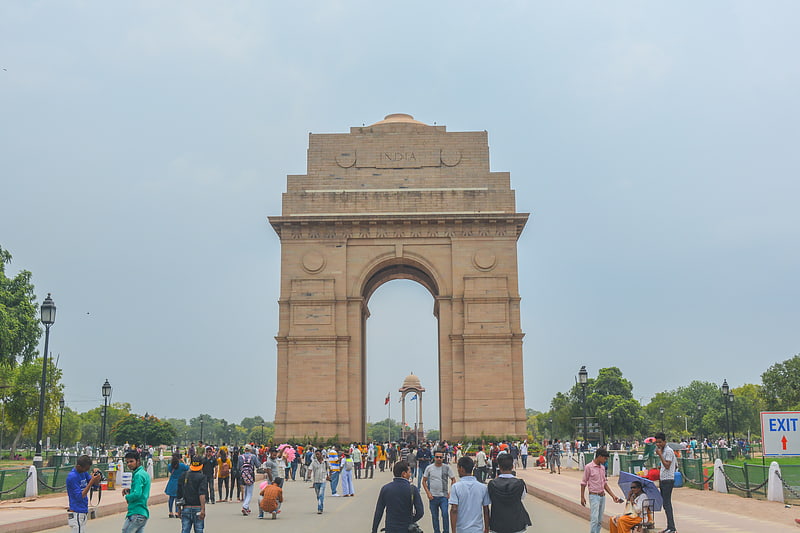
Also known as: इण्डिया गेट
1920s triumphal arch and war memorial. The India Gate is a war memorial located astride the Rajpath, on the eastern edge of the "ceremonial axis" of New Delhi, formerly called Kingsway. It stands as a memorial to 90,000 soldiers of the British Indian Army who died in between 1914 and 1921 in the First World War, in France, Flanders, Mesopotamia, Persia, East Africa, Gallipoli and elsewhere in the Near and the Far East, and the Third Anglo-Afghan War. 13,300 servicemen's names, including some soldiers and officers from the United Kingdom, are inscribed on the gate. Designed by Sir Edwin Lutyens, the gate evokes the architectural style of the memorial arch such as the Arch of Constantine, in Rome, and is often compared to the Arc de Triomphe in Paris, and the Gateway of India in Mumbai.
Following the Bangladesh Liberation war in 1972, a structure consisting of a black marble plinth with a reversed rifle, capped by a war helmet and bounded by four eternal flames, was built beneath the archway. This structure, called Amar Jawan Jyoti (Flame of the Immortal Soldier), has since 1971 served as India's tomb of the unknown soldier. India Gate is counted amongst the largest war memorials in India and every Republic Day, the Prime Minister visits the gate to pay their tributes to the Amar Jawan Jyoti, following which the Republic Day parade starts. India Gate is often a location for civil society protests.[6]
Address: India Gate C-Hexagon, Delhi (New Delhi)
Jama Masjid
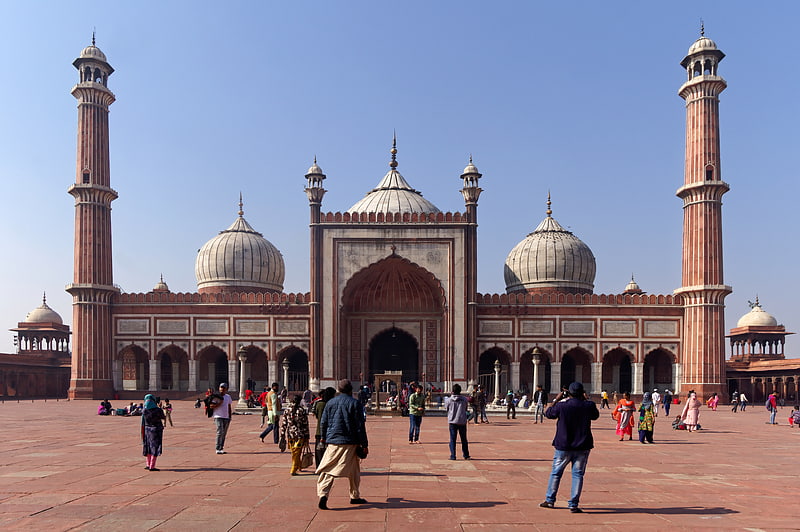
Also known as: जामा मस्जिद, दिल्ली
Vast, 17th-century Mughal-style mosque. The Masjid-i Jehan-Numa, commonly known as the Jama Masjid of Delhi, is one of the largest mosques in India.
It was built by the Mughal Emperor Shah Jahan between 1650 and 1656, and inaugurated by its first Imam, Syed Abdul Ghafoor Shah Bukhari. Situated in the Mughal capital of Shahjahanabad (today Old Delhi), it served as the imperial mosque of the Mughal emperors until the demise of the empire in 1857. The Jama Masjid was regarded as a symbolic node of Islamic power across India, well into the colonial era. It was also a site of political significance during several key periods of British rule. It remains in active use, and is one of Delhi's most iconic sites, closely identified with the ethos of Old Delhi.[7]
Address: Meena Bazaar, Delhi (Central Delhi)
Iron Pillar
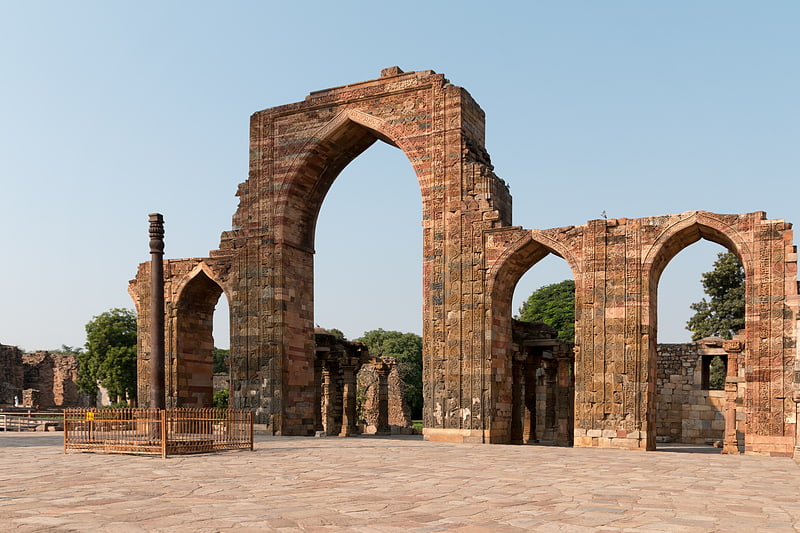
Also known as: लौह स्तंभ
Monument in New Delhi, India. The iron pillar of Delhi is a structure 23 feet 8 inches high with a 16-inch diameter that was constructed by Chandragupta II, and now stands in the Qutb complex at Mehrauli in Delhi, India. It is famous for the rust-resistant composition of the metals used in its construction. The pillar weighs over three tonnes and is thought to have been erected elsewhere, perhaps outside the Udayagiri Caves, and moved to its present location by Anangpal Tomar in 11th century.[8]
Rashtrapati Bhavan
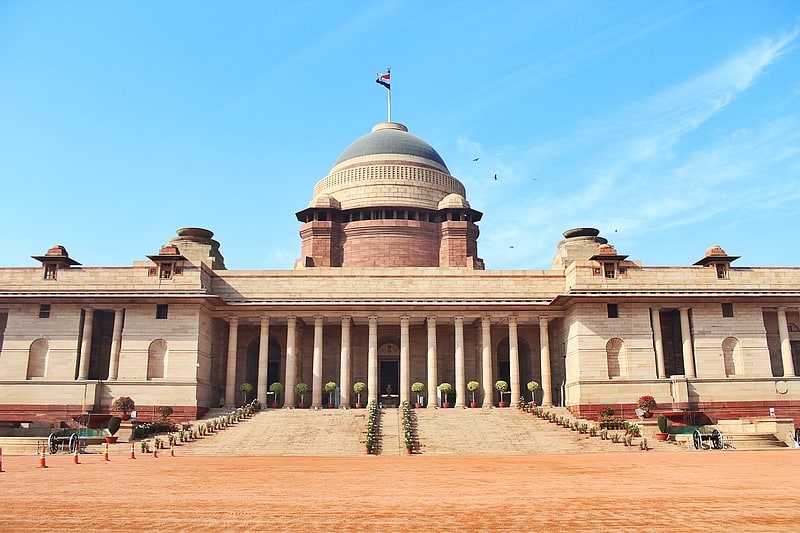
Also known as: राष्ट्रपति भवन
President's official home, with museum. The Rashtrapati Bhavan is the official residence of the President of India at the western end of Rajpath in New Delhi, India. Rashtrapati Bhavan may refer to only the 340-room main building that has the president's official residence, including reception halls, guest rooms and offices, also called the mansion; it may also refer to the entire 130-hectare Presidential Estate that additionally includes the presidential gardens, large open spaces, residences of bodyguards and staff, stables, other offices and utilities within its perimeter walls. In terms of area, it is the largest residence of any head of state in the world.[9]
Address: Raisina Hills, Delhi (New Delhi)
Khan Market

Also known as: खान मार्किट, दिल्ली
Shopping center in New Delhi, India. Khan Market, is a shopping district and retail market in New Delhi, India. It was established in 1951 by the newly constituted Republic of India's Rehabilitation Ministry to give economic opportunities to refugees of the Partition of India, especially those from the North West Frontier Province, now Khyber Pakhtunkhwa, a province in Pakistan. Many such refugees had arrived in the Delhi region. It is named after Khan Abdul Jabbar Khan, also known as Dr. Khan Sahib, who was the Chief Minister of NWFP from 1945 to 1947, and who had helped many refugees to escape without harm. Khan was the elder brother of the Pashtun- and Indian-freedom activist Khan Abdul Gaffar Khan. In 2019, Khan Market was rated as the world's 20th most expensive commercial street by Cushman & Wakefield.[10]
Address: Subramanium bharti marg, Delhi (New Delhi)
Tomb of Isa Khan
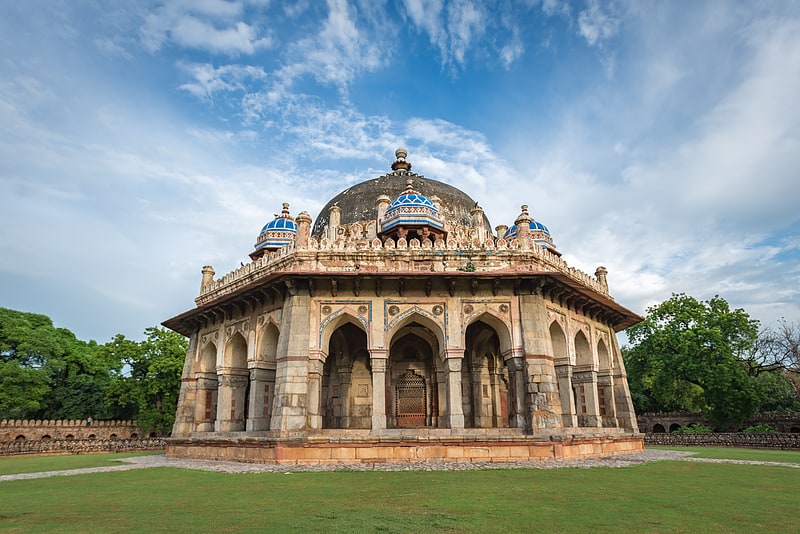
The tomb of the noble Isa Khan Niazi is located in the Humayun's Tomb complex in Delhi, India. The mausoleum, octagonal in shape and built mainly of red sandstone, was built in 1547–1548 during the reign of Sher Shah Suri. The mosque of Isa Khan is located west of the mausoleum, which along with other buildings form the UNESCO World Heritage Site of Humayun's tomb complex.[11]
National Science Centre
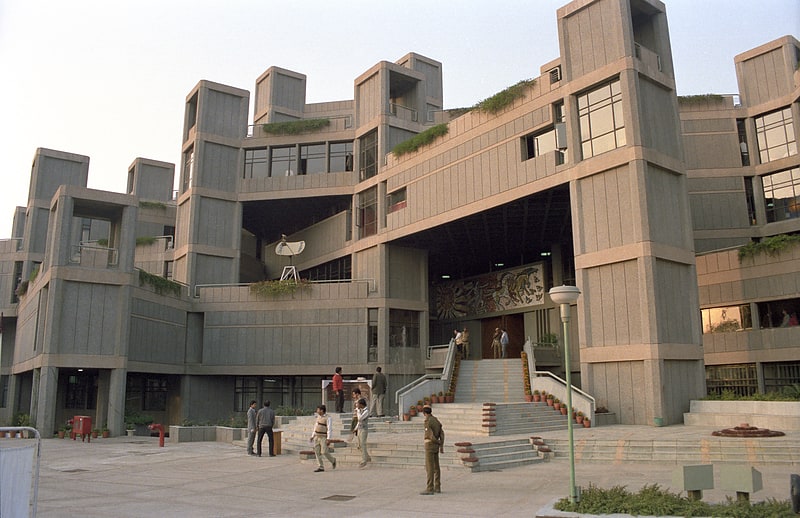
Also known as: राष्ट्रीय विज्ञान केंद्र, दिल्ली
Museum in New Delhi, India. The National Science Centre established in 1992, is a science museum in Delhi, India. It is part of the National Council of Science Museums, an autonomous body under India's Ministry of Culture. It stands close to Gate no 1, of Pragati Maidan overlooking the Purana Qila.[12]
Address: Bhairon Marg, 110001 New Delhi (Central Delhi)
Chandni Chowk
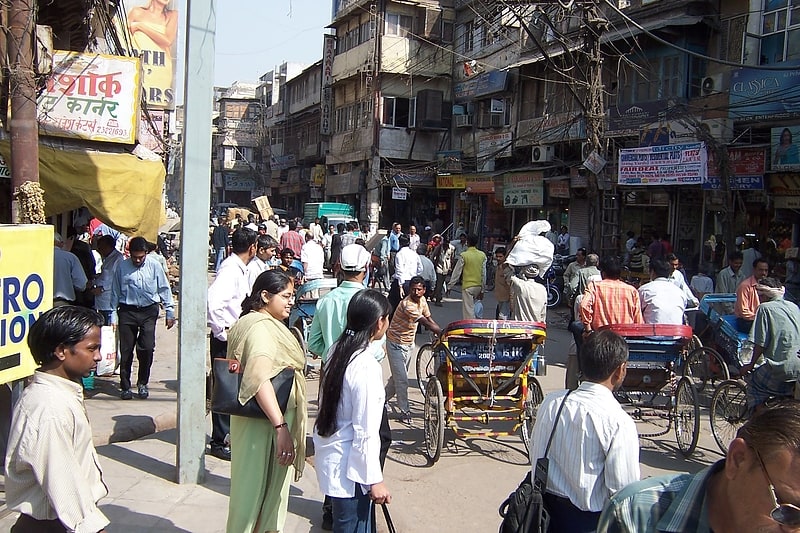
Also known as: चाँदनी चौक
Red Fort and crowded, colorful markets. The Chandni Chowk, also known as Moonlight Square is one of the oldest and busiest markets in Old Delhi, Delhi, India. It is located close to the Old Delhi Railway Station. The Red Fort monument is located at the eastern end of Chandni Chowk. It was built in the 17th century by Mughal Emperor of India Shah Jahan and designed by his daughter Jahanara. The market was once divided by canals to reflect moonlight and remains one of India's largest wholesale markets.[13]
Purana Qila
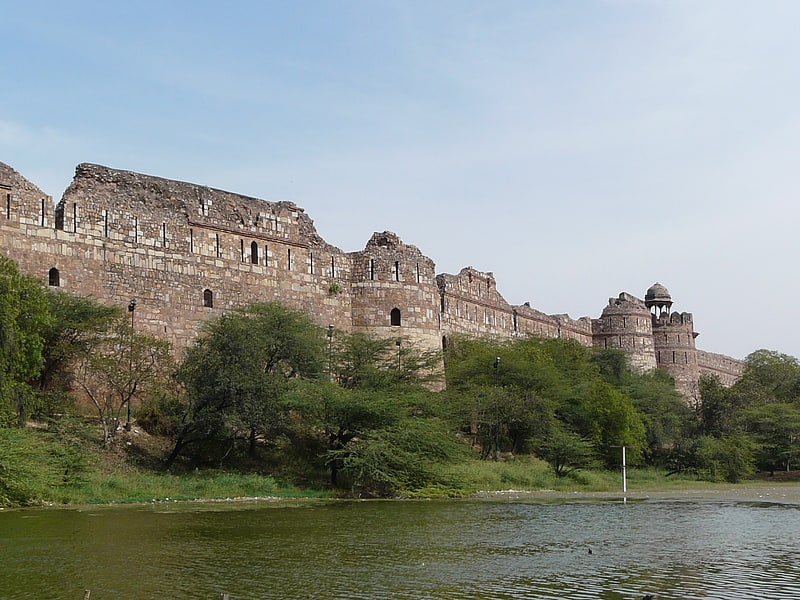
Also known as: पुराना किला, दिल्ली
Riverside fortress with Mugal-era gates. Purana Qila is one of the oldest forts in Delhi, India. Built by the second Mughal Emperor Humayun and Surid Sultan Sher Shah, it is thought by many to be located on the site of the ancient city of Indraprastha. The fort formed the inner citadel of the city of Dinpanah. It is located near the expansive Pragati Maidan exhibition ground and is separated from the Dhyanchand Stadium by the Mathura Road, Delhi.[14]
Address: Purana Qila, Mathura Road, Delhi (Central Delhi)
Lotus Temple
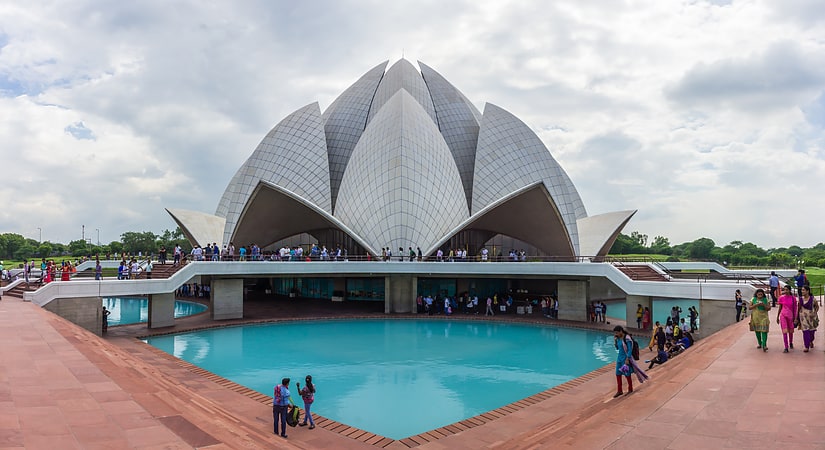
Also known as: कमल मंदिर
Temple with a flower-like design. The Lotus Temple, located in Delhi, India, is a Baháʼí House of Worship that was dedicated in December 1986. Notable for its flowerlike shape, it has become a prominent attraction in the city. Like all Houses of Worship, the Lotus Temple is open to all, regardless of religion or any other qualification. The building is composed of 27 free-standing marble-clad "petals" arranged in clusters of three to form nine sides, with nine doors opening onto a central hall with a height of slightly over 34 meters and a capacity of 1,300 people. The Lotus Temple has won numerous architectural awards and has been featured in many newspaper and magazine articles.[15]
Address: Bahapur, Kalkaji, 110019 New Delhi (South Delhi)
National Zoological Park Delhi
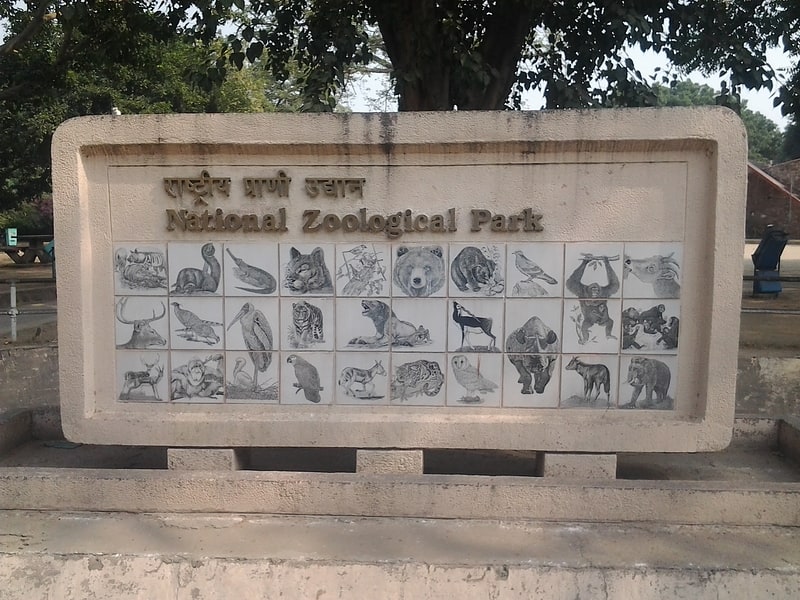
Also known as: वन्य प्राणी उद्यान, दिल्ली
Sprawling zoo known for its white tigers. The National Zoological Park is a 176-acre zoo in New Delhi, India. A 16th-century citadel, a sprawling green island and a motley collection of animals and birds, all in the middle of a burgeoning urban Delhi. The zoo is home to about 1350 animals representing almost 130 species of animals and birds from around the world. The zoo can be seen on foot or using a battery-operated vehicle which can be rented at the zoo. Visitors are not permitted to bring any food other than drinking water, but there is a canteen in the zoo.[16]
Address: National Zoological Park, 110003 New Delhi (Central Delhi)
Tughlaqabad Fort
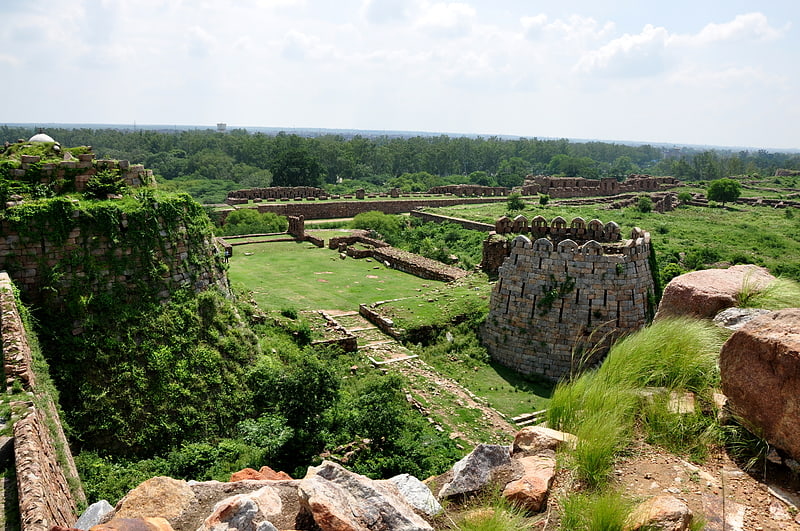
Also known as: तुग़लक़ाबाद
Ruins of Tughlaq-era stone fortress. Tughluqabad Fort is a ruined fort in Delhi, built by Ghiyasuddin Tughluq, the founder of the Tughlaq dynasty, of the Delhi Sultanate of India in 1321, as he established the third historic city of Delhi, which was later abandoned in 1327. It lends its name to the nearby Tughluqabad residential-commercial area as well as the Tughluqabad Institutional Area. Ghiyasuddin Tughluq also built the Qutub-Badarpur Road, which connected the new city to the Grand Trunk Road. The road is now known as Mehrauli-Badarpur Road. The entry fee for the Fort is Rs. 20 for Indians. Also, nearby is Dr. Karni Singh Shooting Range and Okhla Industrial Area.
Surroundings are an important biodiversity area within the Northern Aravalli leopard wildlife corridor stretching from Sariska Tiger Reserve to Delhi. Historical places around the sanctuary are Badkhal Lake, 6 km (3.7 mi) northeast, the tenth century ancient Surajkund reservoir and Anangpur Dam, Damdama Lake, Tughlaqabad Fort and Adilabad ruins (both in Delhi). It is contiguous to the seasonal waterfalls in Pali-Dhuaj-Kot villages of Faridabad, the sacred Mangar Bani and the Asola Bhatti Wildlife Sanctuary. There are several dozen lakes formed in the abandoned open pit mines in the forested hilly area of Delhi Ridge.[17]
Address: Mehrauli-Badarpur Road, Delhi (South Delhi)
Laxminarayan Temple
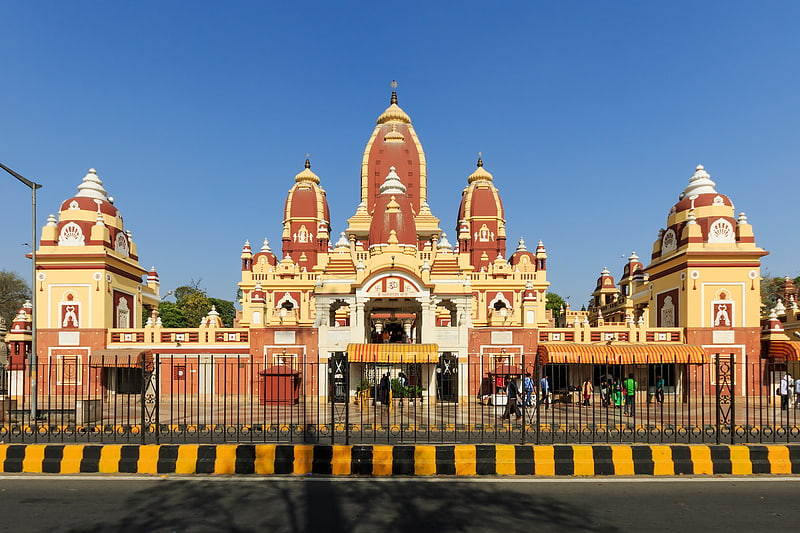
The Laxminarayan Mandir, also known as the Birla Mandir, is a Hindu temple up to large extent dedicated to Laxminarayan in Delhi, India. Laxminarayan usually refers to Vishnu, Preserver in the Trimurti, also known as Narayan, when he is with his consort Lakshmi. The temple, inaugurated by Mahatma Gandhi, was built by Jugal Kishore Birla from 1933 and 1939. The side temples are dedicated to Shiva, Krishna and Buddha.
It was the first large Hindu temple built in Delhi. The temple is spread over 3 hectares (7.5 acres), adorned with many shrines, fountains, and a large garden with Hindu and Nationalistic sculptures, and also houses Geeta Bhawan for discourses. The temple is one of the major attractions of Delhi and attracts thousands of devotees on the festivals of Janmashtami and Diwali.[18]
Address: Mandir Marg, 110001 New Delhi (New Delhi)
Parliament Museum
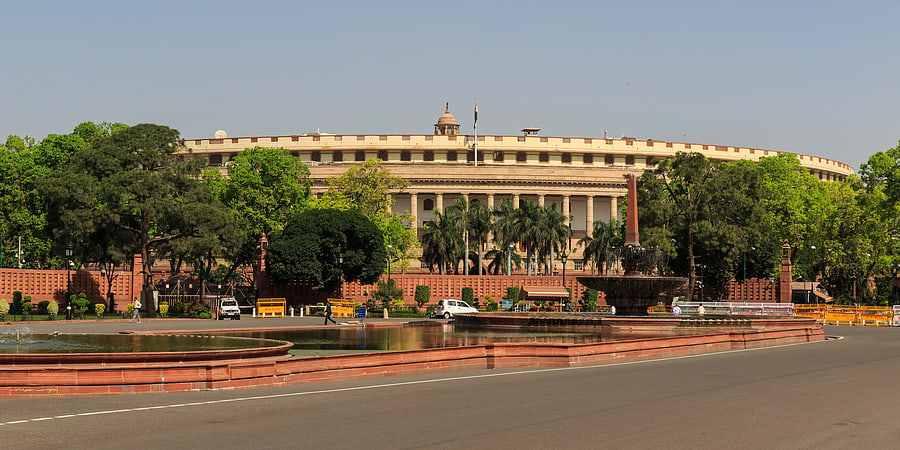
Museum in New Delhi, India. Parliament museum is a museum in the Parliament of India Library Building in New Delhi, close to the Sansad Bhavan. It was inaugurated by then Speaker of Lok Sabha on 29 December 1989, in Parliament House Annexe, subsequently it shifted to its present in a Special Hall of the Sansadiya Gyanpeeth, Parliament Library Building, where it was inaugurated on 7 May 2002 by President of India, K. R. Narayanan. The interactive museum was inaugurated by President A.P.J. Abdul Kalam on 15 August 2006.
It is an interactive museum which tells us the story of freedom struggle of India. It also has rare collection of gifts from foreign delegates to the Speaker of Lok Sabha.[19]
Address: Pandit Pant Marg Area, 110001 New Delhi (New Delhi)
National Handicrafts and Handlooms Museum
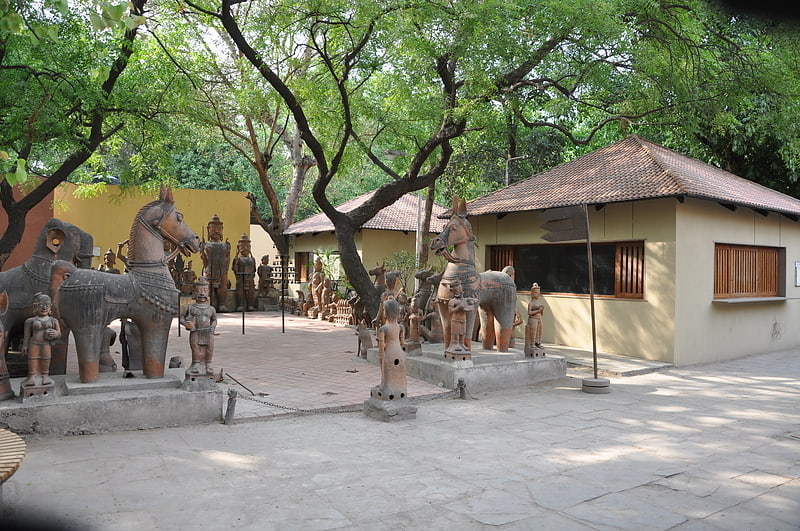
Also known as: शिल्प संग्रहालय, नई दिल्ली
Museum in New Delhi, India. The National Handicrafts and Handlooms Museum commonly known as National Crafts Museum in New Delhi is one of the largest crafts museums in India. It is run by the Ministry of Textiles, Government of India. The museum is situated on the corner of the Pragati Maidan, facing the Purana Qila complex. In 2015, the Government of India announced that a Hastkala Academy would be established in the Museum premises, converting some galleries into classrooms. Initial renovations destroyed one of the museum's most well-known artifacts, a room of murals painted by Madhubani artist Ganga Devi, leading to widespread criticism. As of 2019, renovations are still ongoing.[20]
Address: Pragati Maidan, Gate #5, Bhairon Road, New Delhi-110001, Delhi (Central Delhi)
Jantar Mantar
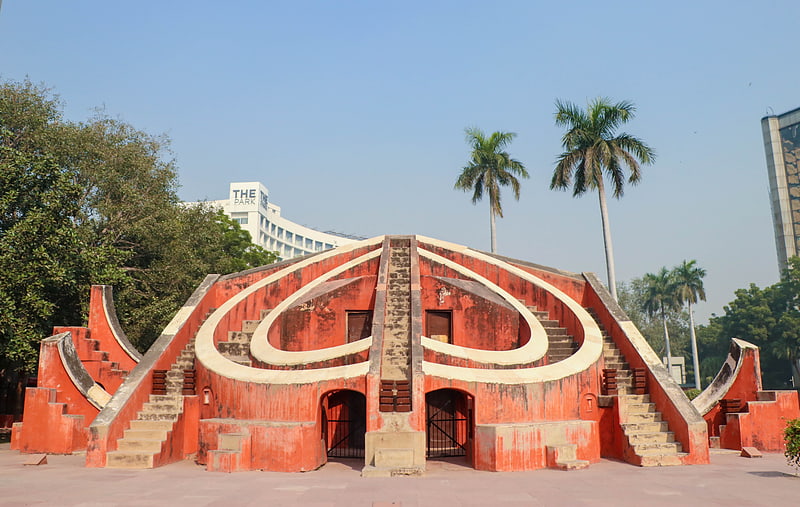
Also known as: जंतर मंतर, दिल्ली
18th-century astronomy complex. Jantar Mantar is located in the modern city of New Delhi. “Jantar Mantar” literally means “instruments for measuring the harmony of the heavens”. It consists of 13 architectural astronomy instruments. The site is one of five built by Maharaja Jai Singh II of Jaipur, from 1723 onwards, revising the calendar and astronomical tables. Jai Singh, born in 1688 into a royal Rajput family that ruled the regional kingdom, was born into an era of education that maintained a keen interest in astronomy. There is a plaque fixed on one of the structures in the Jantar Mantar observatory in New Delhi that was placed there in 1910 mistakenly dating the construction of the complex to the year 1710. Later research, though, suggests 1724 as the actual year of construction. Its height is 723 feet.
The primary purpose of the observatory was to compile astronomical tables, and to predict the times and movements of the sun, moon and planets. Some of these purposes nowadays would be classified as astronomy.
Completed in 1724, the Delhi Jantar Mantar had decayed considerably by 1857 uprising. The Ram Yantra, the Samrat Yantra, the Jai Prakash Yantra and the Misra Yantra are the distinct instruments of Jantar Mantar. The most famous of these structure, the Jaipur, had also deteriorated by the end of the nineteenth century until in 1901 Maharaja Ram Singh set out to restore the instrument.[21]
Address: Sansad Marg, 110001 New Delhi (New Delhi)
Swaminarayan Akshardham
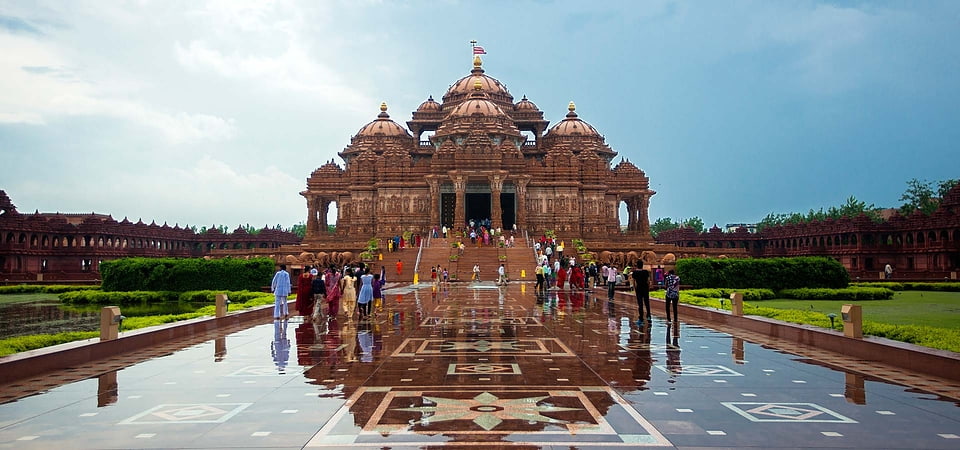
Also known as: अक्षरधाम मंदिर, दिल्ली
Modern temple celebrating Indian arts. Swaminarayan Akshardham is a Hindu temple, and spiritual-cultural campus in Delhi, India. The temple is close to the border with Noida. Also referred to as Akshardham Temple or Akshardham Delhi, the complex displays millennia of traditional and modern Hindu culture, spirituality, and architecture. Inspired by Yogiji Maharaj and created by Pramukh Swami Maharaj, it was constructed by BAPS.
The temple was officially opened on 6 November 2005 by Pramukh Swami Maharaj in the presence of Dr. A. P. J. Abdul Kalam, Manmohan Singh, L.K Advani and B.L Joshi. The temple, at the centre of the complex, was built according to the Vastu shastra and Pancharatra shastra.
In Swaminarayan Akshardham, similar to its predecessor Swaminarayan Akshardham in Gandhinagar, Gujarat, the main shrine is the focal point and maintains the central position of the entire complex. There are various exhibition halls which provide information about the life and work of Swaminarayan. The designers of the complex have adopted contemporary modes of communication and technology to create the various exhibition halls.
The complex features an abhishek mandap, Sahaj Anand water show, a thematic garden, and three exhibitions namely Sahajanand Darshan (Hall of Values), Neelkanth Darshan (an IMAX film on the early life of Swaminarayan as the teenage yogi, Neelkanth), and Sanskruti Darshan (cultural boat ride). According to Swaminarayan Hinduism, the word Akshardham means the abode of Swaminarayan and believed by followers as a temporal home of God on earth.[22]
Address: N. H. 24, Near Noida Mor,110092 New Delhi, Delhi (East Delhi)
Afsarwala tomb
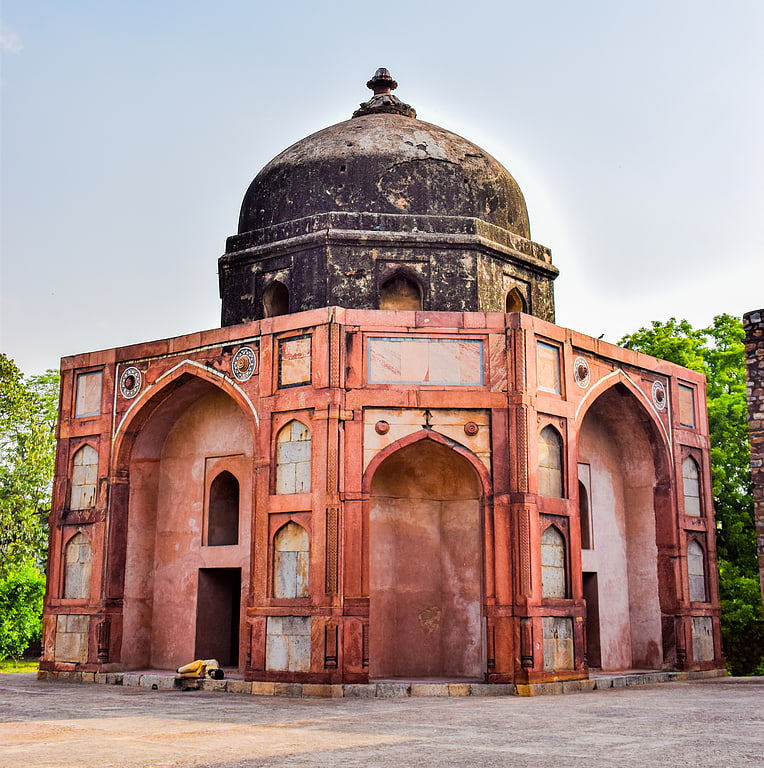
Historical landmark in New Delhi, India. The Afsarwala tomb complex consists of a tomb and mosque, located inside the Humayun's Tomb complex in Delhi, India. The mausoleum houses the tomb of an unknown person. The tomb, together with other structures, forms the UNESCO World Heritage Site of Humayun's tomb complex.[23]
Safdarjung's Tomb
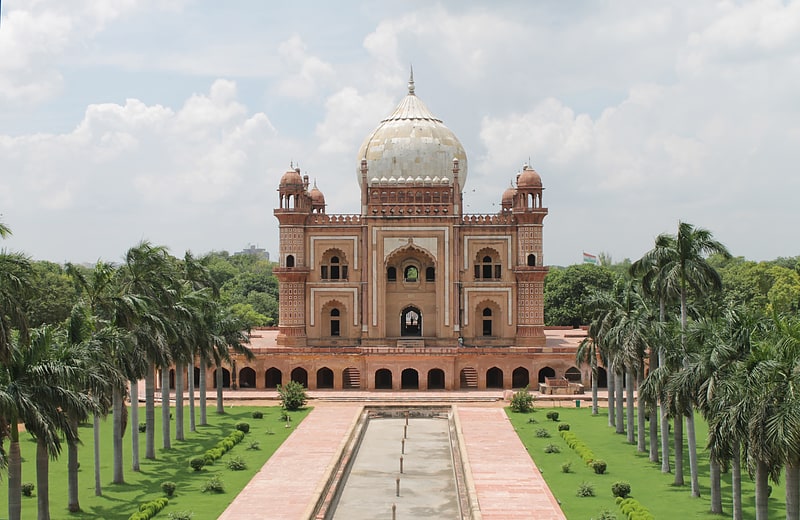
Also known as: सफदरजंग का मकबरा
Elegant garden mausoleum built in 1754. Safdarjung's Tomb is a sandstone and marble mausoleum in Delhi, India. It was built in 1754 in the late Mughal Empire style for Nawab Safdarjung. The monument has an ambience of spaciousness and an imposing presence with its domed and arched red brown and white coloured structures. Safdarjung, Nawab of Oudh, was made prime minister of the Mughal Empire when Ahmed Shah Bahadur ascended the throne in 1748.[24]
Address: Lodi Road, Delhi, Delhi (New Delhi)
National Rail Museum

Also known as: राष्ट्रीय रेल संग्रहालय, नई दिल्ली
Museum for Indian railway history. The National Rail Museum in Chanakyapuri, New Delhi, displays exhibits on the history of rail transport in India. The museum was inaugurated on 1 February 1977. The museum spans over an area of over 11 acres and the indoor gallery comprises an octagonal building which houses six display galleries and a large open area is laid out to simulate the atmosphere of a railway yard. It is open every day except Mondays and national holidays.[25]
Mehrauli Archaeological Park

Historical landmark in New Delhi, India. Mehrauli Archaeological Park is an archaeological area spread over 200 acre in Mehrauli, Delhi, adjacent to Qutub Minar World Heritage Site and the Qutb complex. It consists of over 100 historically significant monuments. It is the only area in Delhi known for 1,000 years of continuous occupation, and includes the ruins of Lal Kot built by Tomar Rajputs in 1060 CE, making it the oldest extant fort of Delhi, and architectural relics of subsequent period, rule of Khalji dynasty, Tughlaq dynasty, Lodhi dynasty of Delhi Sultanate, Mughal Empire, and the British Raj.[26]
Address: Anuvrat Marg, Mehrauli, 110030 New Delhi (New Delhi)
Ghalib Museum
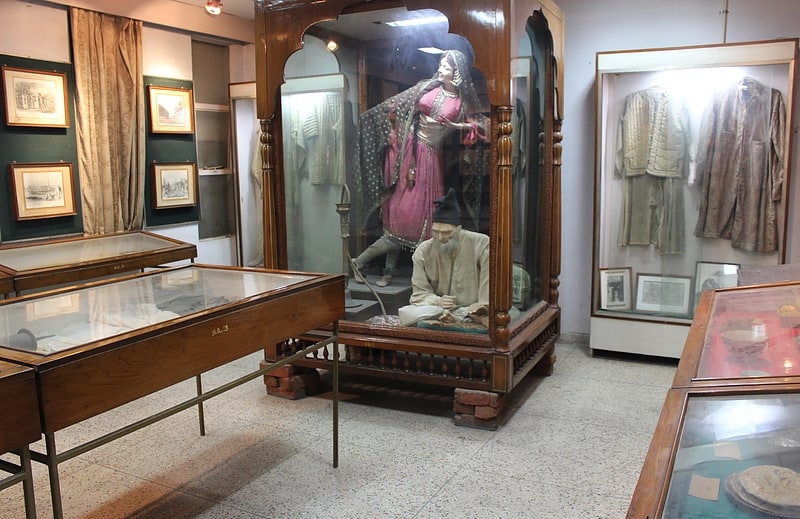
Also known as: गालिब संग्रहालय, नई दिल्ली
Museum in New Delhi, India. Mirza Ghalib Museum, New Delhi is a museum on the life and times of the 18th century Urdu poet Mirza Ghalib, under the aegis of the Ghalib Academy, New Delhi. The museum is situated in the vicinity of the tomb of the 13th century Sufi saint Khwaja Nizamuddin.[27]
Address: Nizamuddin, Nizamuddin West, Delhi (South Delhi)
Gandhi Smriti
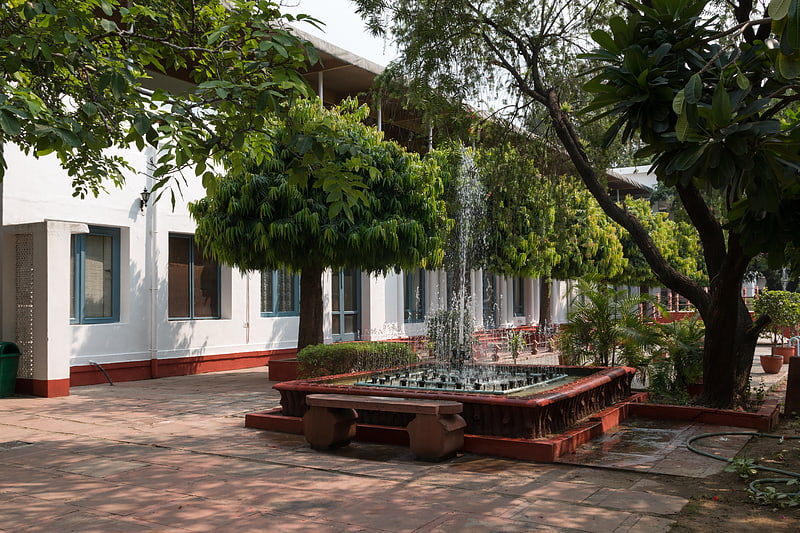
Also known as: गाँधी स्मृति
Museum spotlighting Mahatma Gandhi. Gandhi Smriti, formerly known as Birla House or Birla Bhavan, is a museum dedicated to Mahatma Gandhi, situated on Tees January Road, formerly Albuquerque Road, in New Delhi, India. It is the location where Mahatma Gandhi spent the last 144 days of his life and was assassinated on 30 January 1948. It was originally the house of the Birla family, Indian business tycoons. It is now home to the Eternal Gandhi Multimedia Museum, which was established in 2005.
The museum is open every day except Mondays and national holidays. Entry is free for all.[28]
Address: 5, Tees January Marg, 110001 New Delhi (New Delhi)
Lodi Gardens

Also known as: लोधी उद्यान, दिल्ली
80-acre city park inaugurated in 1936. Lodi Gardens is a city park situated in New Delhi, India. Spread over 90 acres, it contains, Mohammed Shah's Tomb, Tomb of Sikandar Khan Lodi, Shisha Gumbad and Bara Gumbad, architectural works of the 15th century by Lodis - who ruled parts of northern India and Punjab and Khyber Pakhtunkhwa province of modern-day Pakistan, from 1451 to 1526. The site is now protected by the Archaeological Survey of India.
The gardens are situated between Khan Market and Safdarjung's Tomb on Lodi Road and is a popular spot for morning walks for the Delhites.[29]
Address: Lodhi Road, Delhi (New Delhi)
Hauz Khas Complex
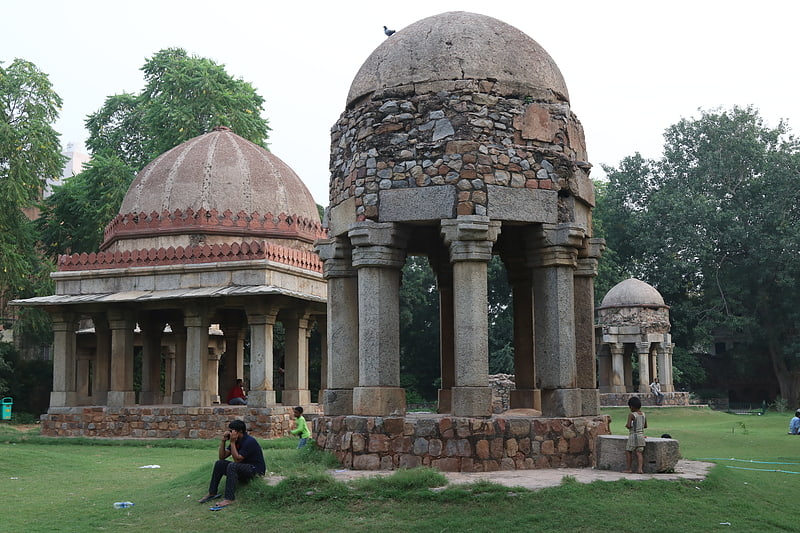
Building complex in New Delhi, India. Hauz Khas Complex in Hauz Khas, South Delhi houses a water tank, an Islamic seminary, a mosque, a tomb and pavilions built around an urbanized village with medieval history traced to the 13th century of Delhi Sultanate reign. It was part of Siri, the second medieval city of India of the Delhi Sultanate of Alauddin Khalji Dynasty. The etymology of the name Hauz Khas in Persian is derived from the words ‘Hauz’: "water tank" and ‘Khas’:"royal"- the "Royal tank". The large water tank or reservoir was first built by Allauddin Khilji to supply water to the inhabitants of Siri. The tank was de–silted during the reign of Firuz Shah Tughlaq. Several buildings and tombs were built overlooking the water tank or lake. Firuz Shah's tomb pivots the L–shaped building complex which overlooks the tank.
In the 1980s, Hauz Khas Village, studded with domed tombs of Muslim royalty from the 14th to 16th centuries, was developed as an upper class residential cum commercial area in the metropolis of South Delhi, India. It is now a relatively expensive tourist cum commercial area with numerous art galleries, upscale boutiques and restaurants.[30]
Address: 9A&12 Hauz Khas Village, Delhi (New Delhi)
Sultan Ghari
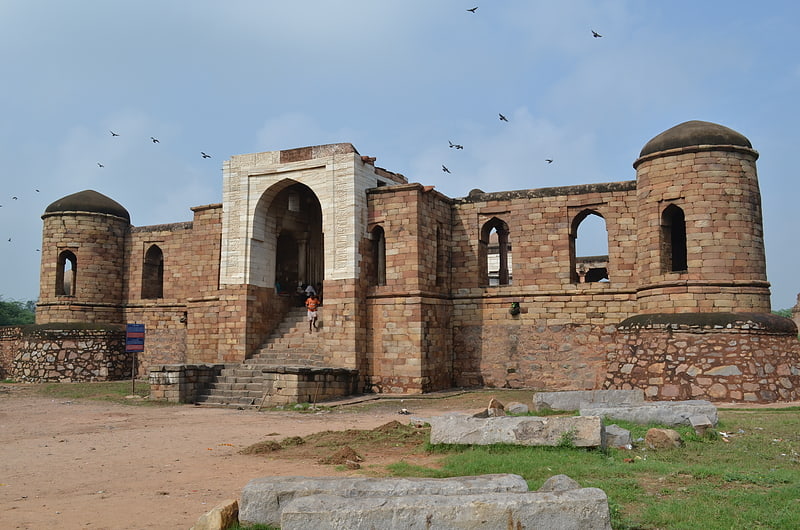
Archaeological site in New Delhi, India. Sultan Ghari was the first Islamic Mausoleum built in 1231 AD for Prince Nasiru'd-Din Mahmud, eldest son of Iltumish, in the "funerary landscape of Delhi" in the Nangal Dewat Forest, Near Nangal Dewat Vasant Kunj).
Iltumish was the third Sultan of the Slave Dynasty who ruled in Delhi from 1210 to 1236 AD. The area where the Ghari (meaning: cave) tomb is situated, was part of medieval Delhi known as the Slave Dynasty that ruled during the period 1206 CE to 1290 CE, pre-existed as a Hindu temple from Gurjara-Pratihara era (700 to 1100 CE). This area is now part of the Qutb complex. The Slave Dynasty was the forerunner under the early Delhi Sultanate that ruled from 1216 CE to 1516 CE. This dynastic city was followed by creation of other five cities of Delhi ruled by different dynastic rulers of the Delhi Sultanate, namely, the Khalji dynasty (1290–1320), the Tughlaq dynasty (1320–1413 CE), the Sayyid dynasty (1414–51 CE), and the Lodi dynasty (1451–1526 CE). The rule of the Mughal Empire then followed and lasted from 1526 CE to 1857 CE.
The crypt or the tomb is implanted in a Ghari (cave), approached by winding steep stairs made of stone, and supported by pillars and flooring. The cave is covered by an unusual octagonal roof stone slab. The exterior of the tomb structure built in Delhi sandstone with marble adornment exhibits a walled area with bastions (towers) on corners, which impart it the look of a fortress in aesthetic Persian and Oriental architecture. The other tombs inside the Ghari have not been identified.[31]
Sunderwala Burj
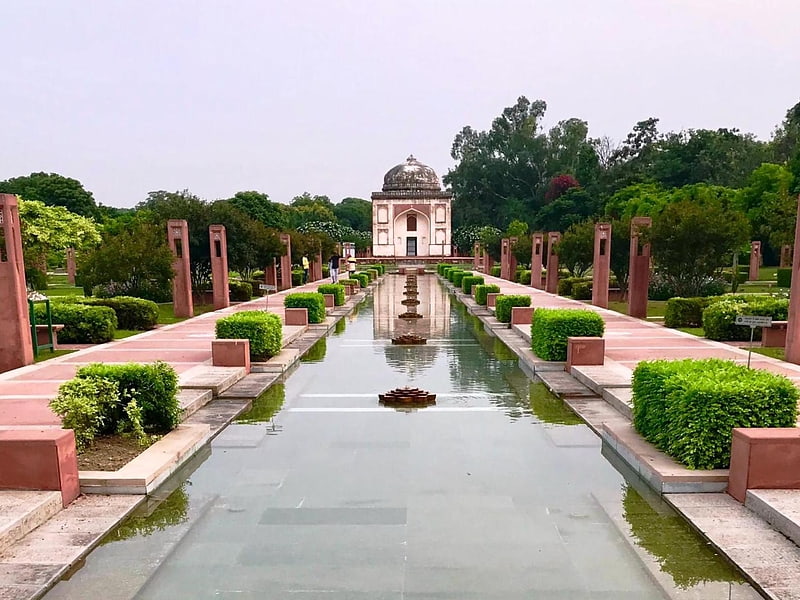
City park in New Delhi, India. Sunder Nursery, formerly called Azim Bagh or Bagh-e-Azeem, is a 16th-century heritage park complex adjacent to the Humayun's Tomb, a UNESCO World Heritage Site in Delhi. Originally known as Azim Bagh and built by the Mughals in the 16th century, it lies on the Mughal-era Grand Trunk Road, and is spread over 90 acres. Future plans aim to link nearby areas to develop it into India's largest park covering 900 acres.
Today Sunder Nursery contains fifteen heritage monuments of which 6 are UNESCO World Heritage Sites, including Archaeological Survey of India (ASI) protected Sundarwala Burj, Sundarwala Mahal and Lakkarwala Burj.
After renovations starting in 2007, the nursery reopened to public as a heritage park on 21 February 2018. Now it contains over 300 types of trees, making it Delhi's first arboretum.
During the British rule, the nursery was established to grow experimental plants, it also has a lake. which gave it its current designation as a nursery. The "Sunder" part of the name comes from the Sunder Burj tomb located in the same premises. Although the name Sunder Nursery has still held, the park has been quoted to be a 'Delhi's Central Park' after renovations (though not to be confused with the central park in Connaught Place, New Delhi).[32]
Lothian Cemetery
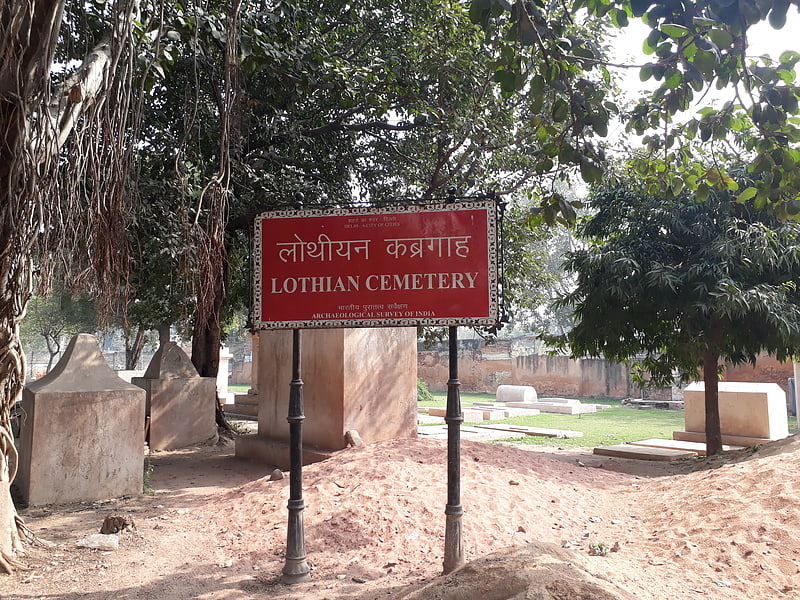
Cemetery in Delhi, India. Lothian Cemetery, is one of the oldest Christian cemeteries of Delhi located in Lothian Road that lies in Kauria Bridge bus stop, near to the General Post Office at Kashmiri Gate in Old Delhi.[33]
Fatehpuri Mosque

Also known as: फ़तेहपुरी मस्जिद, दिल्ली
Lively mosque dating to the 17th century. The Fatehpuri Mosque is a 17th-century mosque located at the western end of the oldest street of Delhi, Chandni Chowk, Delhi, India. It is opposite the Red Fort on the opposite end of Chandni Chowk.[34]
Address: Chandni Chowk Rd, 110006 New Delhi (Central Delhi)
Veer Bhumi

Also known as: राजघाट समाधि परिसर
Simple marble memorial to Mahatma Gandhi. Raj Ghat is a memorial dedicated to Mahatma Gandhi in Delhi, India. Originally it was the name of a historic ghat of Old Delhi. Close to it, and east of Daryaganj was Raj Ghat Gate of the walled city, opening at Raj Ghat to the west bank of the Yamuna River. Later the memorial area was also called Raj Ghat. It is a black marble platform that marks the spot of Mahatma Gandhi's cremation, Antyeshti on 31 January 1948, a day after his assassination. It is left open to the sky while an eternal flame burns at one end. Located on Delhi's Ring Road, officially known as Mahatma Gandhi Road, a stone footpath flanked by lawns leads to the walled enclosure that houses the memorial. The materials used in the memorial, especially in the recesses, raise a few questions about the nature of Gandhian architecture in India. There is a difference between the architecture of Rajghat and a Gandhian low-cost housing architecture. Unlike the hard material faces of some portions of Rajghat, a Gandhian low-cost housing architecture has a decidedly perishable character. In this sense the event of the construction of the Rajghat Memorial belongs within a more hard-modernist Gandhian architectural history in India, distinctly removed from a Gandhian low-cost architectural history of perishable materials.[35]
Address: Gandi Smriti, Delhi (Central Delhi)